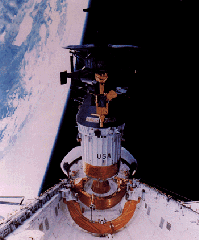
Note: Click on Solar System Exploration: Galileo Legacy Site (NASA-JPL) to get this image at its highest resolution.
Deployment of Galileo and the IUS from the cargo bay of STS-34 Atlantis at 7:15 p.m. EDT on October 18, 1989. P-35213
Mission Specialist Shannon Lucid started Galileo's deployment by pushing a button; automatic systems then took over to separate Galileo from the shuttle. As deployment finished Commander Donald E. Williams declared "Galileo is on its way to another world. It's in the hands of the best flight controllers in this world - fly safely."
Beginning an hour after deployment, two rocket stages of Galileo's IUS booster fired one after the other. Galileo separated from the IUS's second stage at 9:05 p.m. and began its ballistic (or "freefall") flight to Venus for the first of three gravity assisted flybys, which would take Galileo to Jupiter.
Galileo was the second spacecraft to be launched using the IUS (Magellan, the Venus radar mapping mission, was the first. Interestingly, even though Magellan was launched first (in April of 1989), Galileo reached Venus first.). Built by Boeing for the Air Force, the IUS, which uses solid (as opposed to liquid) fuel, gave Galileo an additional speed of 4.0 kilometers per second (8,640 miles per hour).
"Gravity assist" is a technique in which a miniscule fraction of a planet's orbital energy is transferred to a spacecraft, bending its path around the planet and increasing its speed around the Sun, rather like a slingshot or a game of cosmic billiards. Several such maneuvers are necessary to enable Galileo to get to Jupiter. The first gravity assist occurred at Venus on February 10, 1990. Two additional gravity assists from flybys of Earth (on December 8, 1990 and December 8, 1992) also helped to send Galileo on its way. Without the boost provided by these flybys, Galileo would need an extra 10,900 kilograms (23,980 pounds) of propellant - about twelve times more than was on board at launch.
Close flybys and gravity assists utilizing Jupiter's moons will also be used to enable Galileo to make a complex tour of Jupiter's system. An additional 3,600 kilograms (7,920 pounds) of propellant (about four times the total amount of propellant on the spacecraft at launch) would be needed to fly the tour without the billiards-like gravity assist technique.
Next slide: Infrared Image of Low Clouds on Venus
Back to: Galileo To Jupiter
Link to: Solar System Exploration: Galileo Legacy Site (NASA - JPL)
Updated: July 23 '96
Best seen with MS Internet Explorer.
Back: ARVAL - Image Gallery
Messages: